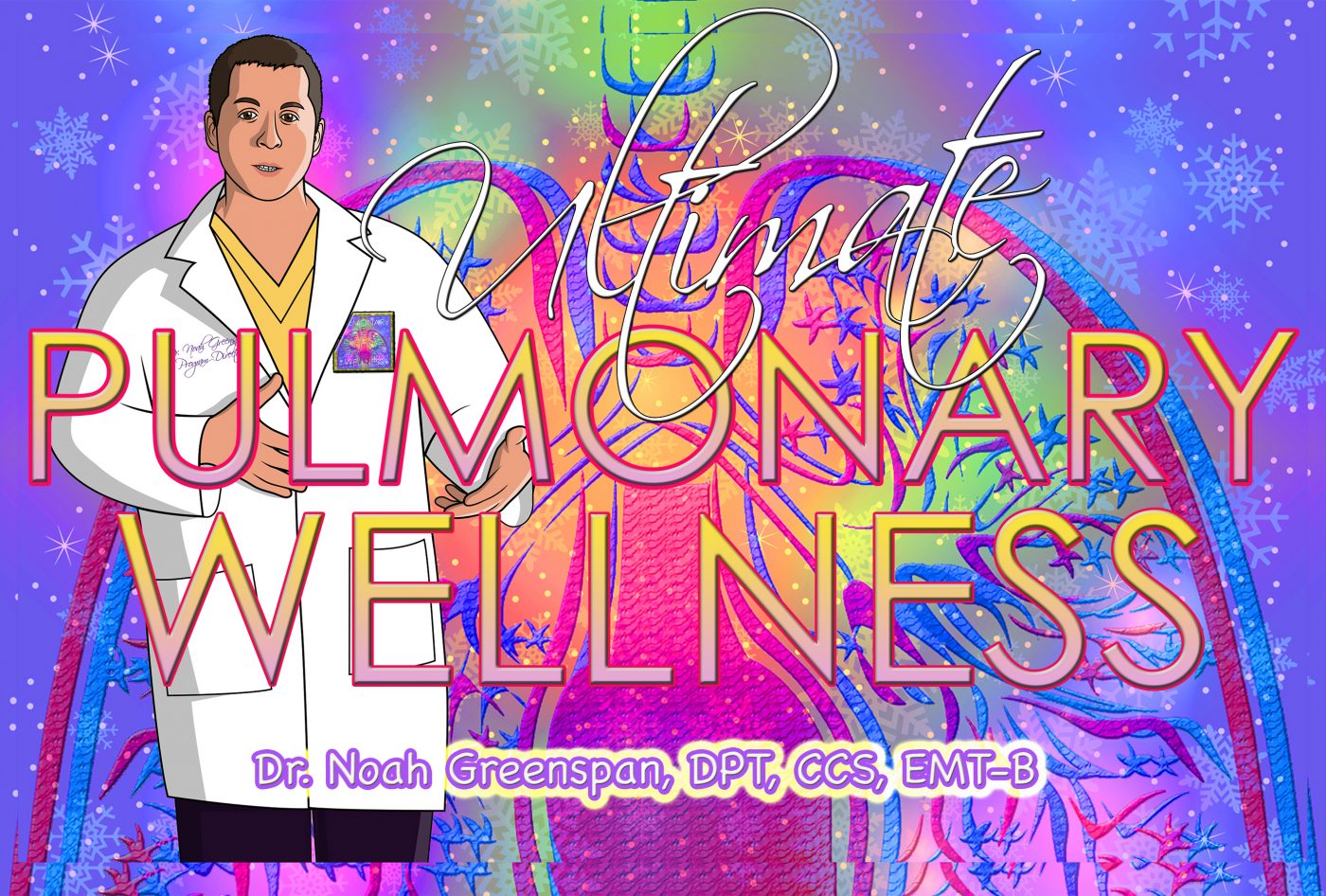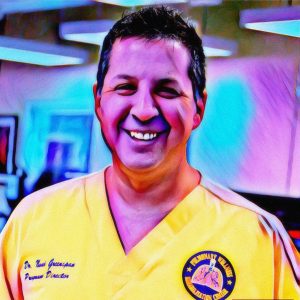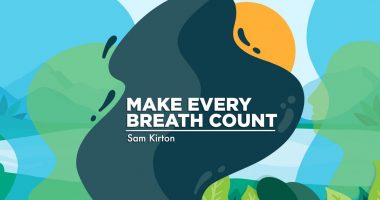Defining Five Main Categories of Pulmonary Wellness: A Rehab Specialist’s Advice

Noah Greenspan, DPT, CCS, EMT-B, cardiovascular and pulmonary clinical specialist. (Image courtesy of Noah Greenspan)
“The whole is greater than the sum of its parts.” — Aristotle
In today’s healthcare environment, an overwhelming percentage of resources are spent on treating diseases and their associated manifestations. While treatment of disease is an essential part of wellness, there is far more to being healthy than simply not being sick. Instead of merely trying to eliminate illness, true wellness is the goal we are striving for — and can be achieved through a combination of positive life changes, education, and enlightenment, all of which can have a potentially powerful impact on both disease treatment and secondary prevention.
With that in mind, my goal is to present you with the information that I have found to be the most successful and most practical over the past 27 years as well as to help guide you in determining which ones will work and which ones won’t work for you.
If you read the classic literature on pulmonary rehabilitation, you will find hundreds of articles stating that after participation in a pulmonary rehabilitation program, participants feel better, can do more, and are less short of breath. However, most of these articles also state that pulmonary rehabilitation does not improve pulmonary function, which can often be disappointing for patients.
Interested in Pulmonary Fibrosis research? Check out our PF forums and join the conversation!
Even though we do not agree with these findings, what this tells us is that if you feel better, can do more, and are less short of breath, without any improvement in pulmonary function, there have to be other factors involved in how well or how poorly you breathe — things such as fitness level, nutrition, and emotional state. This is great news because these are things we actually have some control over.
In this column, we will set the stage for the next several months, years, and hopefully the rest of your life, by identifying the most important principles of Ultimate Pulmonary Wellness.
Let’s start with a few definitions:
Ultimate: The dictionary defines “ultimate” as consummate, maximum, most, or to the highest degree or quantity. I would also add “quality” to this description because I hear people say over and over again — and I also believe — that quality of life is equally, if not more important, than quantity. Our goal is not just for you to feel pretty good. Our goal is for you to feel amazing and to achieve the absolute maximal level of health, function, and quality of life possible.
Pulmonary: “Pulmonary” pertains to the lungs and the respiratory system. When I ask people to rate their understanding of their condition or even the basics of the respiratory system, most people report around a C+ grade level. I don’t know about you, but if you’re living with a chronic pulmonary disease and you have only a C+ understanding of the respiratory system, I consider this a problem.
In an ideal world, when you receive a diagnosis such as chronic obstructive pulmonary disease (COPD), idiopathic pulmonary fibrosis (IPF), pulmonary hypertension (PH), or any other serious medical condition, it would be wonderful if you could spend an hour or two with your doctor, asking questions and taking notes about all the things that you will need to know.
However, in today’s fast-paced healthcare environment, doctors are often so busy that even the greatest, most caring physicians simply do not have the time to teach you everything that you need to know about your illness. That’s my other motivation for Pulmonary Wellness Online and this column.
Wellness: Often, when we seek medical care, we are focused on the exact opposite of wellness. In fact, as a society, we spend far more resources battling sickness than promoting true wellness. Typically, when patients first report their symptoms to their doctor (shortness of breath, cough, or the inability to walk uphill), the first treatments will almost always be medication (or more likely, medications).
However, not enough thought is given to the other factors that come into play when it comes to breathing. Lifestyle choices can either make you feel better or worse depending on which ones you choose to do — or not do — things such as exercise, eating a healthier diet, quitting smoking, taking steps to manage stress and anxiety, and prevention of infection.
The formula
Ultimate Pulmonary Wellness can be divided into five major categories, with each one accounting for approximately 20 percent of total pulmonary and overall health. Those five categories are medical, exercise, nutrition, management of stress and anxiety, and prevention of infection.
Medical (20%)
To me, good medicine means having the right doctors and other healthcare professionals, taking the right medications and taking those medications properly. People ask me all the time, “How do you know if you have the right doctor?” At the most basic level, you probably want a doctor who is smart, experienced, and compassionate. After that, most of us look for any variety of other qualities and character traits. What characteristics do you look for in a doctor? We will help you clarify some of your own physician “makes” or “breaks.”
When it comes to medications, taking the proper medicines is heavily dependent upon having the right doctor, but getting the most benefit from your medicines also depends upon taking them at the right times and in the correct order, as well as using the delivery devices properly. We will discuss these topics in greater detail in a later column, as this is an area I particularly hope to make crystal clear.
Exercise (20%)
When people first start to become short of breath, it usually occurs at high levels of exertion, for example, when doing activities such as stair climbing, walking uphill, or running for the bus. The problem is that people often avoid the activities that cause them shortness of breath. Consequently, all of the muscles that you use to do those activities get weaker and your body becomes less efficient at using oxygen. In addition to teaching you specific breathing exercises, I will guide you through the most beneficial exercises and help you put together a program that will be most effective and best suited for you.
Nutrition (20%)
When it comes to nutrition, in addition to eating a balanced and healthy diet, there are certain concepts that relate particularly to pulmonary disease. These include topics such as the mechanics of eating and breathing or being at your correct (healthy) weight. In addition, there are certain foods that will help you fight your disease and its associated symptoms, while others will make them worse.
Stress and anxiety management/meditation (20%)
Anxiety and depression can have a devastating impact on someone living with a pulmonary disease. To make matters worse, living with a pulmonary disease can cause a tremendous amount of anxiety and depression. This is another cycle we hope to break so you can be less stressed and live a happier, healthier, and more satisfying life.
Prevention of infection (20%)
The final piece of the puzzle is prevention of infection. To be clear, a cold or infection for someone with a respiratory disease can be far more serious than for someone who is otherwise healthy. Plus, people with lung disease often don’t get a little infection. They get big infections, and their infections often go right to the chest.
Because the respiratory system is your weak link, it is crucial that you implement some type of prevention strategy. This effort will be well worth your while, as it is often easier to prevent an infection than to treat one once you’ve got it. I will give you a number of tools and suggestions to help you in your fight against infection.
Everything else (10–100%)
Since we believe in giving 110%, there is an additional 10% left over for a category I like to call “everything else.” What I mean by “everything else” is that even if you do everything right including the “big five” of pulmonary wellness, there will always be factors outside of our control. Being superstitious by nature, I don’t want to name any of them here, but take a deep breath, keep living your life, and expect the unexpected.
***

Dr. Noah Greenspan, DPT, CCS, EMT-B, is a board-certified Clinical Specialist in Cardiovascular and Pulmonary Physical Therapy, with more than 25 years of cardiopulmonary physical therapy and rehabilitation experience. His book “Ultimate Pulmonary Wellness” — a continuing source of pride — was published in 2017, and he has made it available for all to read online free-of-charge using that link or by going to the center’s website, www.PulmonaryWellness.com. His “Ultimate Pulmonary Wellness” Lecture & Webinar Series is also open to attend free-of-charge on the website.
Dr. Greenspan founded the Pulmonary Wellness & Rehabilitation Center, a Manhattan-based physical therapy practice specializing in the care of patients with cardiovascular and pulmonary diseases, in 1998. Under his direction, the Center has conducted over 100,000 exercise sessions and has been named “Best of the United States” in the area of cardiovascular and pulmonary physical therapy.








